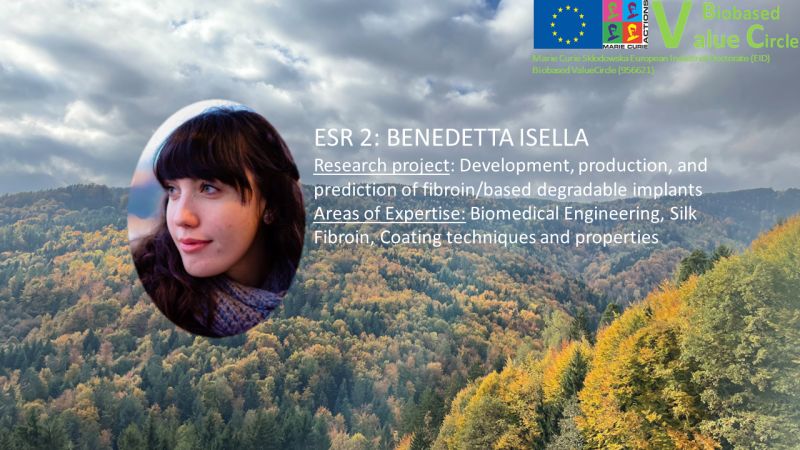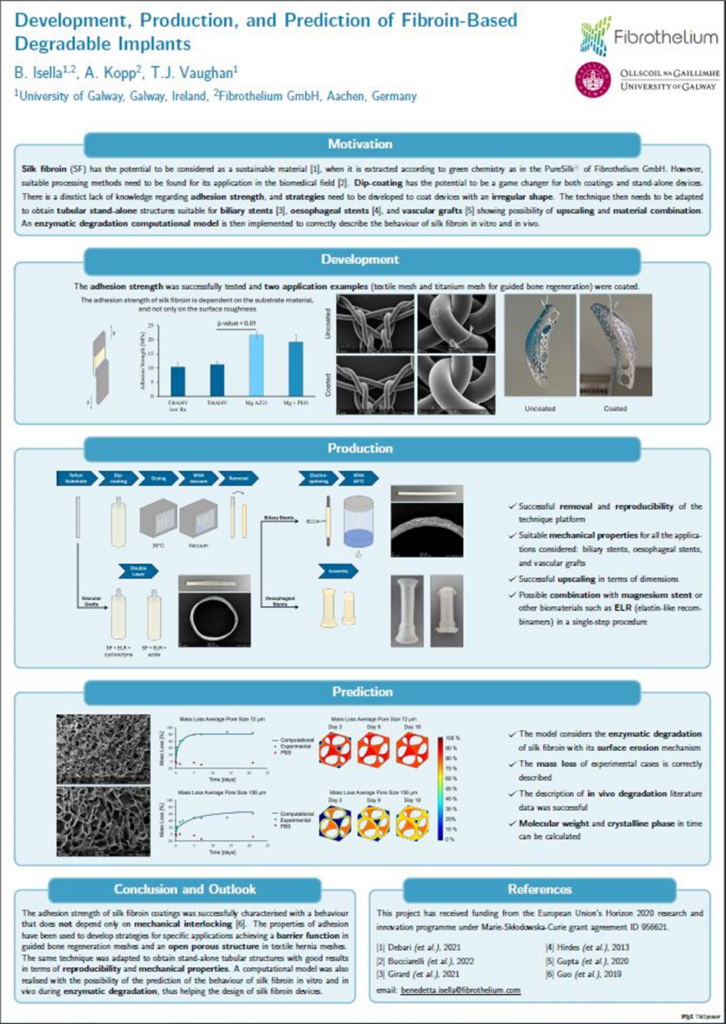
Abstract
Silk fibroin is a protein extracted from silk that exhibits excellent biocompatibility, high mechanical properties, while also being bioabsorbable, which makes it an excellent candidate as a sustainable constituent material of biomedical devices. However, the use of silk fibroin as an implantable material remains limited due to distinct challenges that are encountered during its processing phase, particularly in industrial setting were reproducibility remains an issue and it can be difficult to produce complex structures. Indeed, several methods have been proposed to fabricate silk fibroin components, among which dip-coating is particularly promising given its versatility and scalability. Using a dip-coating process, there is potential to develop new techniques to obtain stand-alone silk fibroin structures, which could be applied for different scopes in the biomedical field. However, there is a general lack of understanding of the adhesion mechanisms of silk fibroin during dip-coating. The objective of this project is therefore to address the issues that affect silk fibroin commercialization by studying the dip-coating technique for both applications as a coating and as stand-alone devices through the production of a range of tubular structure that have potential application in endoluminal settings. Furthermore, a computational model able to describe the phenomenon of enzymatic degradation to aid in the design process.
Publications for Communication and Dissemination
The following activities have been done:
- Training event Biobased Value Circle #5 in Graz, Austria, 8th – 12th May 2023.
Oral presentation of the results in front of other ESRs and supervisors within the consortium - Publication of a peer-reviewed paper in collaboration with Lara Bitar (ESR 1), Francesca Bertella (ESR 5) and Carolina Bettker Vasconcelos (ESR 12), “Sustainable Silk Fibroin for Biomedical Applications: a Molecular Biotechnology Challenge”, Bitar L., Isella B., Bertella F., Bettker Vasconcelos C., Harings J., Kopp A., van der Meer Y., Vaughan T.J., Bortesi L., April 2024.
Target: scientific audience. https://doi.org/10.1016/j.ijbiomac.2024.130374 - ESB, Annual Conference of the European Society for Biomaterials, Davos, Switzerland, 4th – 8th September 2023.
Poster presentation and representation of Fibrothelium GmbH as sponsor, “Layer-by-Layer Deposition of Silk Fibroin Aqueous Solution: Mechanical and Adhesion Properties”, Isella B., Kopp A., Vaughan T.J.
Target: scientific audience. Home | 33rd Annual Conference of European Society for Biomaterials (esb2023.org) - GMS, Greener Manufacturing Show, Cologne, Germany, 8th November 2023.
Oral presentation and representation of Fibrothelium GmbH.
Target: industrial and general audience. https://www.greener-manufacturing.com - Training event Biobased Value Circle #6 in Galway, Ireland, 13th – 17th November 2023.
Oral presentation of the results in front of other ESRs and supervisors within the consortium - BinI, Bioengineering in Ireland, Newcastle, Northern Ireland, 26th – 27th January 2024.
Oral presentation, “Development of a Bilayer Bioresorbable Silk Fibroin Biliary Stent”, Isella B., Drinic A., Kopp A., Vaughan T.J.
Target: scientific audience. https://bini2017.files.wordpress.com/2024/01/bini-2024-abstract-book-v4.pdf - ClusterKonferenz Innovative Medizin NRW, Düsseldorf, Germany, 19th March 2024
Poster and oral presentation, “Development of a Bilayer Bioresorbable Silk Fibroin Biliary Stent”, Isella B., Drinic A., Eickhoff R.M., Vaughan T.J., Kopp A.
Target: scientific and industrial audience. https://www.medizin.nrw/veranstaltungen/clusterkonferenz-2024-innovative-medizin-in-nrw/ - Training event Biobased Value Circle #7 in Maastricht, Netherlands, 15th May 2024
Oral presentation of the results in front of other ESRs and supervisors within the consortium - Symposium “Harnessing the Potential of Biobased Value Circle”, Maastricht, Netherlands, 16th May 2024
Poster and oral presentation, “Development, Production, and Prediction of Fibroin-Based Degradable Implants”, Isella B., Kopp A., Vaughan T.
Target: students, representatives of industry and academia
https://www.maastrichtuniversity.nl/events/harnessing-potential-biobased-value-circles#:~:text=This%20symposium%20is%20the%20culmination,a%20biobased%20and%20circular%20economy. - LinkedIn posts published by both Fibrothelium GmbH and Biobased Value Circle Pages, distributed throughout the year.
Target: academia, industry, and general public.
The following activities are planned:
- Submission of the paper “Novel Silk Fibroin Based Bilayer Scaffold for Bioabsorbable Internal Biliary Stenting”, Isella B., Hassan N., Drinic A., Eickhoff R.M., Vaughan T.J., Kopp A., Summer 2024
Target: scientific audience - Submission of the paper “A Dip-Coating Combination of Silk Fibroin and Elastin-Like Recombinamers for Small-Diameter Vascular Grafts” in collaboration with Federica Sallustio (ESR 9), Isella B., Sallustio F., Acosta S., Andre D., Fernandez-Colino A., Rodriguez-Cabello J.C., Kopp A., Vaughan T.J., Summer 2024
Target: scientific audience - Submission of the paper “Mechanical Properties of a Silk Fibroin and Magnesium Device for Oesophageal Stenting”, Isella B., Merkord F., Emonts C., Hennecken L., Eickhoff R.M., Vaughan T.J., Kopp A., Autumn 2024
Target: scientific audience
Protection of the acquired intellectual property (patents applications) etc.
At the current state, the results obtained could not be considered to be protected or marketed. However, the results showed the ability of silk fibroin in coating and forming smooth layers also on surfaces with a complex geometry. An idea could be to investigate more this aspect and to solve an existing technical problem such as the coating of porous substrates. The patent in this case could be related not only to the specific material but also to the technique used. Since this possibility is still an idea and it has not been realized yet, it is not possible to state the contributions from the different inventors.
Impact on science and/or technology
The tests performed in terms of lap-shear adhesion strength test have the potential to compare organic and inorganic coatings using the same setup in a reproducible way. This means that the same methodology could be potentially used even in other studies with different coatings with the advantage of having full comparability. Furthermore, the mechanism of adhesion of silk fibroin cannot be explained by a single adhesion mechanism deepening the knowledge in this field and the technological application of aqueous silk fibroin coatings deposited by dip-coating, which can be considered an alternative for many different research thanks to its versatility.
The production of prototypes for biliary and oesophageal stents and vascular grafts opens the door to other potential tests regarding both in vitro tests such as cytocompatibility, hemocompatibility, and cell culture and in vivo such as animal trials to verify the functionality of the devices and their implantability. This project also demonstrated an extreme versatility of silk fibroin which can be considered as a suitable material to produce samples in different fields ranging from nerve grafts to tracheal reconstruction. Furthermore, the integration of two different materials in the same technique is the precursor of the potential combination of different polymers allowing to tune and combine the mechanical, biological, and degradation properties.
Finally, an important contribution is also given by the computational model which could be used to determine the degradation rate not only of silk fibroin but also of other polymers degrading through enzymatic degradation such as collagen. The adoption and improvement of this model could therefore have an impact in the scientific community allowing for a finer design and prediction of bioabsorbable prototypes.
Impact on innovation (companies)
The work done in this project could have interesting implications for companies. Indeed, the versatility and scalability of the processing platform of silk fibroin lays the foundation for a larger production of tubular structures for medical applications. Considering the various structures that can be replicated by silk fibroin tubes (e.g., bile ducts, nerves, vessels, oesophagus, trachea, catheters), this could impact several industries and even big players in the biomedical field. Furthermore, the processing technique has shown the potential to be reproducible, an essential feature for the approval in the current FDA or Medical Device Regulation processes.
In general, the dip-coating technique has shown potential also for coating and not only as stand-alone structures given the possibility of obtaining both thin layers and thick barrier layers which may be required by different specific applications. In addition, the morphology of dip-coating with its smooth morphology could impact cell behavior to prevent adhesions.
This entire process could positively impact the use of silk fibroin in clinical settings because of its simplicity, scalability and reproducibility giving more importance to a fully bioabsorbable material. In addition, the same technique could potentially be extended to other biopolymers improving the adoption of bioabsorbable materials in the biomedical field. The technology used is also green and does not imply the use of toxic chemicals helping in the transition towards a sustainable and biobased economy.
Finally, the adoption of a computational model could help in the design of the final devices and could even allow to find a correlation between in vitro degradation experiments and in vivo conditions, overcoming the problem of unpredictability of the degradation rate of the final devices and thus enhancing the adoption of silk fibroin in industry.
Impact on society
The work done in this thesis could be helpful for several groups in our society.
Firstly, the increase in the need for B. mori cocoons could promote the development of agricultural communities with a focus on sustainable cultivation of mulberry trees and silkworms. This model has already been shown to have a positive impact on the societies especially in countries currently under development [71].
Furthermore, this project has provided insights into the use of silk fibroin as a coating. This could positively impact patients especially undergoing maxillofacial surgeries or hernia repairs by improving the removal of the titanium meshes for guided bone regeneration or reducing the possible visceral adhesions and so complications after hernia surgery.
In addition, this project has shown the possibility of applying silk fibroin in three different areas of application, namely biliary stenting, oesophageal stenting, and vascular grafting. These devices, being completely bioabsorbable, do not need a second reintervention for the removal, decreasing the risks for the patients and the healthcare costs. Moreover, the prototypes proposed showed high reproducibility and are off-the-shelf devices that offer therefore a higher availability simplifying the surgical procedures.
The increase in silk fibroin and the presence of a reliable and reproducible technique could also be the starting point for further research impacting so students and academic institutions and for further business development, even if for this last step it would be critical to introduce more devices on the market according to both the new Medical Device Regulation in the European Union and FDA.
Visual Summary – Poster

